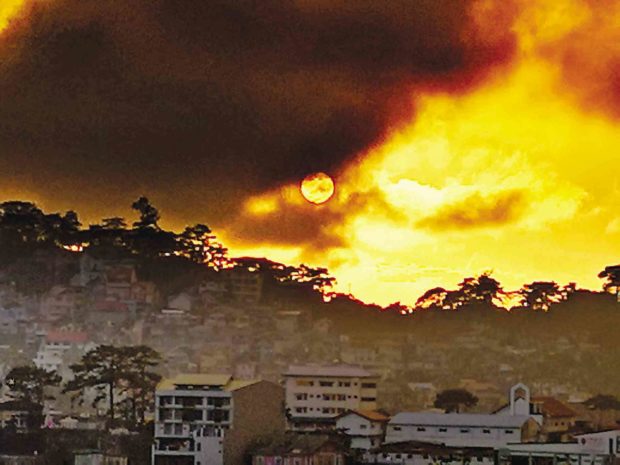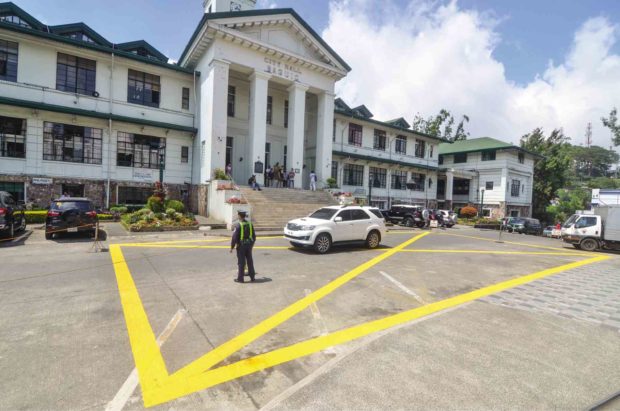
GOLDEN HOUR Sunsets in Baguio City are among the priceless moments for residents and visitors of the summer capital. —EV ESPIRITU
Former Foreign Secretary Alberto Romulo remembered Baguio through vignettes about shopping at the public market where he would reconnect with friends.
“You can buy anything in the market—vegetables and strawberries—which the city’s frequent visitors take back home, and walk through its fog-wrapped streets or take boat rides at Burnham Lake,” said the 86-year-old Romulo, also a former senator.
Much has improved, Romulo said, admitting he was pleasantly surprised that traveling to this city these days has become a much shorter trip.
“I started from Manila at 7 a.m. and I was here at 11 a.m.,” he said. Romulo was here last month to open a P4.3-billion credit facility for Baguio’s redevelopment projects as chair of the Development Bank of the Philippines.
He was the latest official to offer Baguio a hand, following a public clamor to address overcrowding and the city’s overdevelopment.
Claustrophobia
During the last election campaign, Mayor Benjamin Magalong said he had a front-seat preview of the claustrophobia some residents lamented they suffered from unending high-rise constructions, the vanishing pine trees, the deteriorating market, traffic gridlocks, and a growing trash and sewage problem.
As soon as he assumed office in July, Magalong set off to find solutions.
In January, Romulo’s daughter, Tourism Secretary Bernadette Romulo-Puyat, allocated P480 million for the century-old Burnham Park—a prelude to the modernization of many of the city’s tourist destinations.
Environment Secretary Roy Cimatu and Interior Secretary Eduardo Año promised to shepherd a proposed moratorium on tree cutting and future building constructions.

SEAT OF GOVERNMENT The Baguio City Hall is one of the most iconic buildings in the Cordillera. —KARLSTON LAPNITEN
Fixing the city
Some 20 companies, technology leaders and businessmen have pitched ideas to fix Baguio’s problems.
Among them are professionals like architect Rafael Chan, who submitted designs for parking buildings for Burnham Park as a way to discourage vehicles from entering this most-visited Baguio greenbelt.
“My designs are my strongest contribution to the improvement of the city. My personal advocacy is to make the whole park free of cars. We grew up biking around the lake, using park roads, which motorists now use as a shortcut,” Chan said.
Coarse correction
In February, families who have spent their lives selling at the market have invited residents to share their resources with a homegrown development company that intends to bid for some projects and prevent big developers from taking over prime real estate.
Magalong said the city government was not reconstructing Baguio, which was built by the American colonial government at the start of the 20th century.
He said many of the issues required “coarse correction.” Traffic pylons, for example, were installed to keep traffic flow moving in congested areas where rerouting schemes were employed.
Backyard piggeries were banned to reduce pollution at the headwaters of rivers that flow from Baguio down to the provinces of Benguet and La Union.
City Hall has also reviewed and upgraded its business and environment fees, and has asked for an increase in property taxes because the city government needs money to finance these projects, Magalong said.
Big-ticket projects
But plans for big-ticket projects drawn up by private and public experts are ambitious and herculean and will take more time to complete, although some are scheduled to start this year.
These were drawn up to deal with resources that no longer serve the current population, pegged by a 2019 Baguio carrying capacity study at 700,000 during daytime.
According to the study, Baguio’s huge population breached the carrying capacity of its roads in 1985, solid waste management facilities in 1995, water resources in 2002, wastewater treatment in 2007, and its forest cover in 2012.
LEADER Mayor Benjamin Magalong (right) presides over a meeting with city officials during a visit at Irisan dump. —KARLSTON LAPNITEN
THE MARKET
Set up as soon as the American colonial government opened Baguio’s doors to migrants after 1909, the market had always been the center for trading vegetables, fruits, flowers and souvenirs produced by farmers, artists and craftsmen of Benguet.
The Baguio government initiated the modernization of the market in 1995, but its lease development project was stalled in court for 20 years when vendors questioned its constitutionality.
Master plan: Last year, a new master plan approved by the vendors introduced four interconnected buildings where shoppers could buy meat, fish, vegetables, fruits, flowers and souvenir items.
The buildings would have small parks, a series of walkways connecting the city to downtown Baguio and Burnham Park, and parking spaces.
But the project would cost the government at least P6 billion. Baguio intended to secure a loan and build the market. But mall giants SM and Robinsons have submitted unsolicited proposals to build the market, which the Baguio government may open to a Swiss challenge. Magalong assured Baguio vendors that they would be protected from unfair competition.
THE POWER PLANT
The first key undertaking in Baguio’s redevelopment was the installation of a waste-to-energy plant which would be fueled by 200 tons of waste generated by the city each day.
Initiated by the previous administration, the plan was revived last year when the Department of Energy invited officials of Japanese engineering firm Toyo Energy Solutions Inc.
Toyo offered to build a biomass generator, originally at the Baguio Dairy Farm on Marcos Highway.
Waste to energy: As of Feb. 24, the Japanese government had approved a grant for the power generation plant, which would be relocated to Barangay Pinsao, according to City Administrator Bonifacio dela Peña.
The Japanese government negotiated the revenue shares of Baguio, the Philippine National Oil Co. that facilitated the government-to-government arrangement, and Toyo and a local contractor.
At least five other waste management companies offered solutions that would convert Baguio waste to electricity, which the city government was considering to handle medical waste and toxic trash.
At present, Baguio has been hauling its waste to commercial landfills in Tarlac and Pangasinan provinces since the closure of its only dump at Irisan.
CLEANING WASTEWATER
The summer capital was one of the first urban areas to be served by a sewage treatment plant, which was put up 33 years ago through a Japanese grant.
The plant cleans wastewater discharged into the Balili River, which flows to vegetable gardens in nearby La Trinidad Valley in Benguet. The facility, however, is outdated and will need upgrades to expand its services from the current 10 percent of the Baguio population.
Sewer lines upgrade: The city government will also need to repair and expand its sewer lines spanning 61 kilometers. City officials have met with the Asian Development Bank, which is studying the proposed sewage upgrade. Initial estimates indicate that the comprehensive sewage project could cost up to P22 billion. Several wastewater companies have proposed to build three more satellite treatment plants along three other river headwaters.
Septic management: On Feb. 24, the city council approved on second reading a proposed septic management ordinance that would enforce the periodic treatment of household septage and regulate “poso negro” (septic tank cleanup) providers.
The city government also discussed the enforcement of a sewage treatment fee to be included in water rates collected by the water utility and by private water delivery services.

